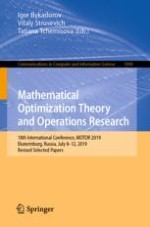2019 | Buch
Mathematical Optimization Theory and Operations Research
18th International Conference, MOTOR 2019, Ekaterinburg, Russia, July 8 - 12, 2019, Revised Selected Papers
herausgegeben von: Igor Bykadorov, Prof. Dr. Vitaly Strusevich, Prof. Tatiana Tchemisova
Verlag: Springer International Publishing
Buchreihe : Communications in Computer and Information Science
